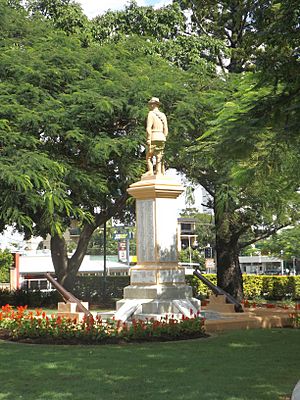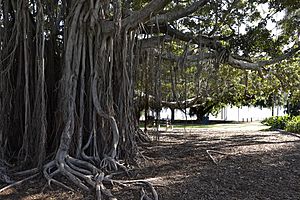Mowbray Park and East Brisbane War Memorial facts for kids
Quick facts for kids Mowbray Park and East Brisbane War Memorial |
|
|---|---|

Memorial in 2015
|
|
| Location | 33, 60 & 78 Lytton Road, East Brisbane, Queensland, Australia |
| Design period | 1900 – 1914 (early 20th century) |
| Built | 1904–1974 |
| Official name: Mowbray Park and East Brisbane War Memorial, Riversdale | |
| Type | state heritage (built, landscape) |
| Designated | 21 October 1992 |
| Reference no. | 600189 |
| Significant period | 1850s–1976 (historical) 1904– (social) 1904–1936 (fabric) |
| Significant components | park / green space, lawn/s, gate – entrance, memorial – soldier statue, pathway/walkway, flagpole/flagstaff, swimming pool |
| Lua error in Module:Location_map at line 420: attempt to index field 'wikibase' (a nil value). | |
| Mowbray Park | |
|---|---|

Mowbray Park in East Brisbane
|
|
| Location | Brisbane, Queensland, Australia |
| Area | 32,000m² |
| Created | 1904 |
| Operated by | Brisbane City Council |
| Designation | State Heritage Place (Queensland Heritage Register) |
Mowbray Park and the East Brisbane War Memorial are important historical sites in East Brisbane, Queensland, Australia. This lovely park and its special monument are listed on the Queensland Heritage Register. They were built between 1904 and 1974. The park is a green space for everyone to enjoy, and the memorial helps us remember brave soldiers, sailors, and nurses.
A Look Back: The Park's Story
How Mowbray Park Began
In 1903 and 1904, the South Brisbane City Council bought a large piece of land. It was called Mowbray's Paddock. This land was owned by Reverend Thomas Mowbray in the 1850s. The Council wanted to turn it into a public park.
The new park was officially named Mowbray Park in September 1904. Reverend Thomas Mowbray had arrived in Moreton Bay in 1847. He helped start the Presbyterian Church in Brisbane in the 1850s. He bought about 12 acres (4.9 ha) of land along the Brisbane River. On this land, he built his family home, Riversdale.
Why This Spot Was Chosen
In 1903, the Council thought Mowbray's property was perfect for a park. It had good soil and sloped down to the river. It was also big enough for bowling greens, tennis courts, and croquet lawns. The land faced northeast and had great views of the river. It was also above flood level and on the tram route. There were no other public parks nearby.
The Council bought the land from James Anderson Mowbray, Thomas's son. This included the current park and nearby areas. These areas later became home to a bowling club, croquet club, and tennis courts.
Early Features of the Park
In 1904, new entrance gates were put up at Mowbray's Paddock. The old house, Riversdale, was sold and moved. That same year, the East Brisbane Bowling Club started. The Council leased a part of the park to them. In 1906, parts of the park were also leased to the East Brisbane Croquet Club and Tennis Club.
The riverbank at Mowbray Park often eroded. So, the Council decided to build a stone wall to protect it. In 1906, they also planned to add a swimming bath and a landing stage. Construction of the retaining wall began in 1908.
In 1910, a kiosk (a small shop) and a cottage were built in the park. A bandstand was also built in 1911, where bands could play music. A jetty or landing stage was also built around 1911 for boats.
The First World War Memorial
Between 1916 and 1917, the first First World War Memorial in Brisbane was built here. Local people raised money for it. It was an honour roll and a statue. It remembered all the soldiers, sailors, and nurses from the East Brisbane and Kangaroo Point area.
The statue shows an Australian Light Horseman, which is rare for Queensland memorials. It was carved by Alfred Batstone. The memorial was unveiled on 11 August 1917. It had two cannons next to it and a garden shaped like a cross. More names were added to the honour rolls during and after the war.
Swimming Baths and Caretakers
The idea of swimming baths at Mowbray Park came up many times. Finally, in 1919, the Council decided to build a swimming area in the Brisbane River. It was finished in late 1919 or early 1920. A Mowbray Park Swimming Club started, and the baths became very popular.
In 1920, the Council decided that a married couple should manage the kiosk and baths. The wife would run the kiosk, and the husband would be the caretaker for the baths and park. They set rules for the baths, like separate swimming times for males and females. Changing rooms were added by 1922.
Changes Over Time
In 1925, Mowbray Park became part of the new Greater Brisbane City Council. The park was a popular place for sailing races in the 1920s and 1930s. In 1936, the Church of England Grammar School built a boat house for their rowing club. This boat house is still there today and is one of the oldest along the Brisbane River.
During the Great Depression in the early 1930s, Mowbray Park was a "tent city" for families who had lost their homes.
In 1974, the First World War Memorial was moved to its current spot. This was to make space for the East Brisbane Bowling Club to expand. Around 1976, the old kiosk and caretaker's cottage were taken down. The swimming enclosure was also removed earlier, but the stone walls and steps from the baths are still there.
In 1996, Brisbane City Council started the CityCat ferry service. One of the ferry stops, the Mowbray Park ferry wharf, was built next to Mowbray Park.
More recently, between 2018 and 2020, some trees along Lytton Road were moved or removed for road upgrades. New lights were added under special trees and at the war memorial. Free Wi-Fi was also installed in the park.
What You Can See Today
Mowbray Park is about 3.2 hectares (7.9 acres) of green lawns and trees. It gently slopes down to the Brisbane River from Lytton Road. You can still see parts of the old swimming baths in the northwest corner. A boat house is in the northeast corner. The park also has the beautiful First World War Memorial.
Park Features
The park has many old trees and paths.
- A main path lined with palm trees goes from Lytton Road to the river.
- Another palm-lined path crosses the southeast part of the park.
- A path in the northwest goes past old eucalyptus trees.
- A path along the river has ornamental trees like Bauhinias and Jacarandas, and a row of palm trees.
- A higher path runs parallel to the river and is lined with fig trees.
You can also find groups of large fig trees in different parts of the park. There's a grove of eucalyptus and pine trees in the southeast and a grove of large fig trees in the northeast.
Old Swimming Baths and Boat House
The old swimming baths have two stone walls built into the river's edge. The lower wall is about 100 metres (330 ft) long. It has two sets of stone steps that lead into the water. The upper wall is about 70 metres (230 ft) long. Timber pylons (poles) mark where the baths used to be. Boats are now tied to these pylons.
The boat house is a large, single-storey timber shed. It has a tiled roof and timber walls. Inside, you can see the wooden beams. A timber boat ramp is next to the shed.
The War Memorial
The War Memorial is near the Lytton Road end of the park, on the central path. It has a statue on a tall base, with two cannons on either side. The statue is life-size and made of sandstone. It shows an Australian Light Horseman with a rifle.
The base has four large marble plaques with 520 names of soldiers, sailors, and nurses. The granite base has four steps and four more marble plaques with 196 additional names. Three smaller plaques remember when the foundation stone was laid and when the memorial was unveiled.
The cannons are 9-pounder steel cannons. They have the Royal monogram of Queen Victoria on them. A tall flagpole stands right next to the memorial.
Why Mowbray Park is Important
Mowbray Park and the East Brisbane War Memorial are listed on the Queensland Heritage Register. This means they are very important to Queensland's history and culture.
A Link to the Past
The park shows how East Brisbane developed over time. It was first connected to the Mowbray family, who owned a lot of land here. It also shows how the South Brisbane City Council worked to create public green spaces as the city grew.
The stone retaining wall and steps from the old swimming baths show how people used to enjoy the Brisbane River for fun. Mowbray Park, like Newstead Park, is one of the few places that still shows what riverside estates looked like in the mid-1800s. Many other similar properties are now gone.
Unique and Beautiful
The East Brisbane War Memorial is special because of its beauty and how well it was made. The statue of the Australian Light Horseman is rare in Queensland war memorials. It also shows the great work of the stonemasons, W Batstone & Sons. The memorial is a unique source of historical information.
Mowbray Park is one of the few inner Brisbane parks that offers a large open space with river views. It is a beautiful, green area that adds to the local scenery. It has old trees and structures that show how it has changed over the years.
A Place for the Community
For over 90 years, Mowbray Park has been a central place for the local community. People come here for recreation and to remember important events. The boat house and the old swimming bath walls show how the park has always been a place for riverside community activities.

